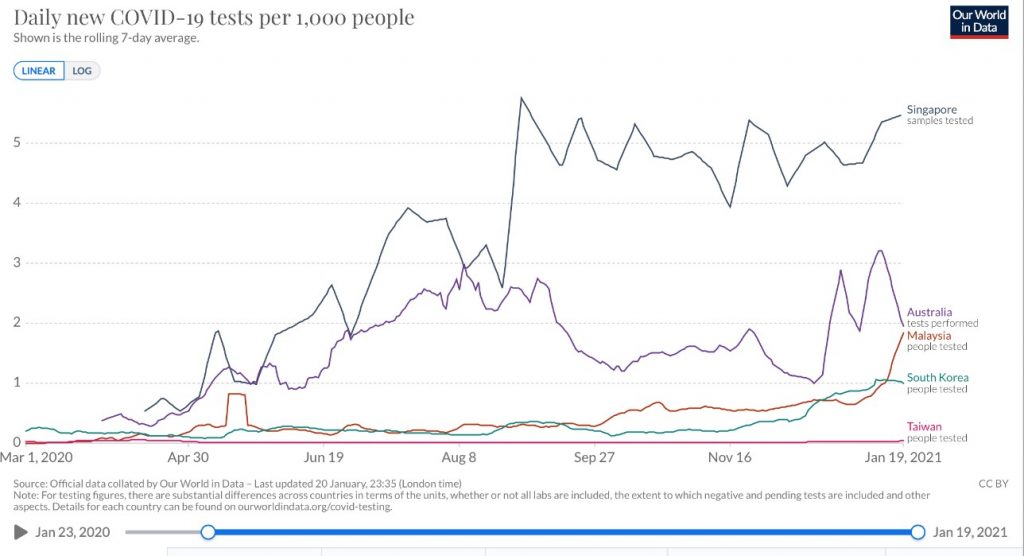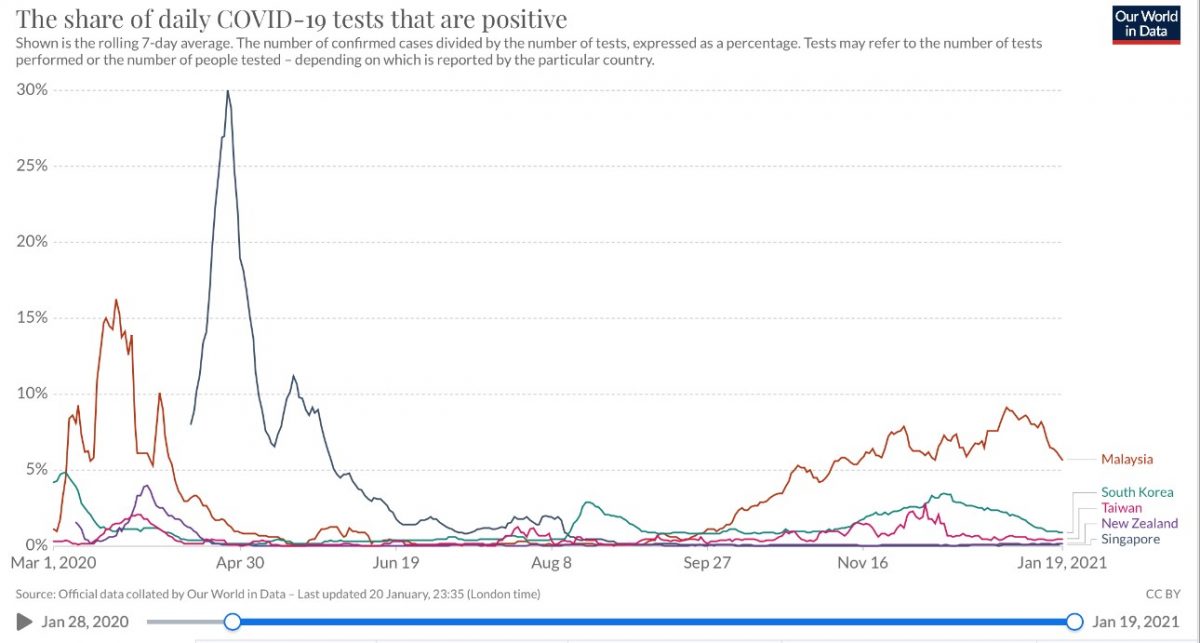KUALA LUMPUR, Jan 21 — For 10 weeks now since November 6, the positive rate for Covid-19 tests in Malaysia has been above five per cent, exceeding the World Health Organization’s (WHO) maximum target.
According to Our World in Data, Malaysia’s Covid-19 test positive rate (the share of tests that are positive) has maintained above five per cent since November 6, based on a rolling seven-day average, peaking on January 1 this year with a positive rate of 9.1 per cent. Malaysia’s positive rate subsequently declined to six per cent on January 18.
With WHO’s recommended positive rate of less than five per cent, this means that Malaysia has not been testing enough to capture mild or asymptomatic Covid-19 cases, detecting only people with symptoms or severe conditions.
Since November, Malaysia’s reported average daily cases have been rising continuously from an average of 1,089 cases between November 6 and November 19, to an average of 2,923 cases between January 5 and January 18.
While these official figures seem high, under-testing means that the actual number of Covid-19 cases in Malaysia could be much higher.
The Ministry of Health (MOH) does not reveal the positive rate in their daily Covid-19 reports, which is actually an essential element in identifying if there’s a high number of undetected cases in the community. However, MOH noted Tuesday that the proportion of severe Covid-19 cases has risen to 15 per cent of daily infections, from two to three per cent during the second wave of the epidemic. This could indicate either under-testing (missing mild or asymptomatic cases), or delayed presentation to the health care system that could worsen outcomes.
WHO recommended in May last year that the positive rate should be maximum five per cent for at least two weeks, an indicator that the epidemic is under control in a country, before governments consider reopening their countries.
On January 18, based on a rolling seven-day average, Malaysia’s positive rate was six per cent, higher than countries like South Korea (0.9 per cent), Taiwan (0.5 per cent), New Zealand (0.2 per cent), and Singapore (0.1 per cent).
As of January 10, CodeBlue had also reported that 92.9 per cent of active clusters in Malaysia had a positive rate of above five per cent, while 30 of them had a positive rate more than 50 per cent. This means that every one in two people tested from that cluster will be positive for Covid-19.
Despite the high positive rate, MOH has not maximised testing based on their actual capacity, which is 60,093 RT-PCR tests a day.
Health director-general Dr Noor Hisham Abdullah reported that on January 18, a total of 35,720 RT-PCR tests were done nationwide, which only amounted to 59 per cent of their total capacity.
However, based on Our World In Data, the number of tests Malaysia conducted on January 18 was 59,731. This could possibly include both RTK-Ag and RT-PCR tests that were carried out.
Singapore, Australia Conduct More Tests Per Population Than Malaysia

The daily new Covid-19 tests per 1,000 people in Malaysia since November 6 were not consistent. On November 6, MOH carried out 0.71 tests per 1,000 population and then 0.53 tests per 1,000 population on November 8.
The number of tests carried out per 1,000 population were below one between November 6, 2020 until January 8, 2021, when 1.08 tests were conducted per 1,000 population.
On January 11, the number of tests per 1,000 population dropped again to 0.95. Following January 11, the number of tests per 1,000 population consistently increased to 2.08 tests per 1,000 population on January 14. The number of people who got tested per 1,000 population then declined to 1.75 per 1,000 population on January 19.
From November 6 till December 20, Singapore conducted more tests per 1,000 population, followed by Australia, Malaysia, South Korea, and Taiwan. On December 21, South Korea conducted 0.72 tests per 1,000 population, more than Malaysia which conducted 0.71 tests per 1,000 population.
Malaysia then on January 13 conducted more tests per population (1.07) than South Korea (1.05). Malaysia has been conducting more tests than South Korea and Taiwan per 1,000 population as of January 19.
However, Singapore and Australia remained higher than Malaysia in conducting more tests per 1,000 population.
Health director-general Dr Noor Hisham, in a letter to state health department directors, said that effective from January 13, Covid-19 screening will only be done for close contacts who are symptomatic with Covid-19, but those without symptoms can self-isolate at home for 10 days, without getting tested.
Dr Noor Hisham said the number of test samples to be taken for Covid-19 clusters or close contacts will depend on the size of the cohort, which is defined as the number of individuals exposed to the virus in the cluster.
Health expert Dr Musa Nordin told CodeBlue that MOH is overwhelmed by the number of tests.
“Facilitate private testing by capping (the) price of RTK-Ag testing by the National Security Council,” Dr Musa said. “RTK-Ag cost RM150 to RM280 in private (health centres).”
He also pointed out how different assemblymen in Selangor, such as Subang Jaya assemblywoman Michelle Ng and Bukit Gasing assemblyman Rajiv Rishyakaran, are coming forward to provide more reasonably priced RTK-Ag tests for their own constituents at RM50 to RM70.
Dr Musa added that the Selangor state government is setting aside RM5 million for free testing and have mass tested 20,000 people so far, separate from MOH testing.
Singapore, which has reported a total of 59,157 positive Covid-19 cases, has conducted 6.06 million tests cumulatively compared to Malaysia that has reported 169,379 cases and only conducted 4.05 million tests cumulatively as of January 18.
Former Malaysian Medical Association (MMA) president Dr Milton Lum in his op-ed stated that the positive rate in Malaysia had increased from 14.04 per cent on November 29, 2020 to 20.47 per cent on January 17, 2021. This, he said, likely reflected increased spread of the virus among migrant workers. The government made it mandatory from January 1 for migrant workers to be screened.
Migrant workers in Malaysia do not always have designated dormitories to live in. Most of them live in rented homes in residential areas among the local community, which fosters the spread of Covid-19 from foreign workers to the general public.








